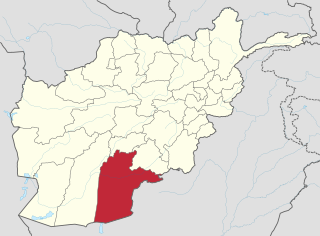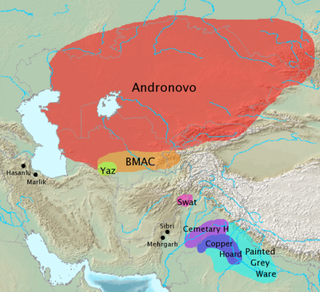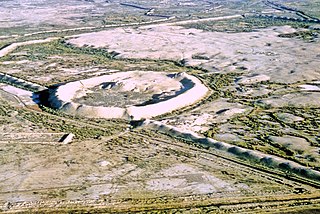Related Research Articles

Kandahar is a city in Afghanistan, located in the south of the country on the Arghandab River, at an elevation of 1,010 m (3,310 ft). It is Afghanistan's second largest city after Kabul, with a population of about 614,118. It is the capital of Kandahar Province as well as the de facto capital of the Taliban, formally known as the Islamic Emirate of Afghanistan. It also happens to be the centre of the larger cultural region called Loy Kandahar. In 1709, Mirwais Hotak made the region an independent kingdom and turned Kandahar into the capital of the Hotak dynasty. In 1747, Ahmad Shah Durrani, founder of the Durrani dynasty, made Kandahar the capital of the Afghan Empire.

Kandahār is one of the thirty-four provinces of Afghanistan, located in the southern part of the country, sharing a border with Pakistan, to the south. It is surrounded by Helmand in the west, Uruzgan in the north and Zabul Province in the east. Its capital is the city of Kandahar, Afghanistan's second largest city, which is located on the Arghandab River. The greater region surrounding the province is called Loy Kandahar. The Emir of Afghanistan sends orders to Kabul from Kandahar making it the de facto capital of Afghanistan, although the main government body operates it Kabul. All meetings with the Emir take place in Kandahar, meetings excluding the Emir are in Kabul.

The Bactria–Margiana Archaeological Complex or Oxus Civilization, recently dated to c. 2250–1700 BC, is the modern archaeological designation for a Bronze Age civilization of Central Asia, previously dated to c. 2400–1900 BC, by Sandro Salvatori, in its urban phase or Integration Era.
Jim G. Shaffer is an American archaeologist and professor of anthropology at Case Western Reserve University.
Bampur (Persian: بمپور, also Romanized as Bampūr and Bampoor) is a city in and capital of Bampur County, Sistan and Baluchestan Province, Iran. At the 2006 census, its population was 9,073, in 1,664 families.

The Jiroft culture also known as the Intercultural style or the Halilrud style, is a postulated early Bronze Age archaeological culture, located in the territory of present-day Balochistan and Kermān Provinces of Iran. The hypothesis is based on a collection of artifacts that have been formally excavated and recovered from looters by Iranian authorities; accepted by many to have derived from the Jiroft area in south central Iran, as reported by online Iranian news services, beginning in 2001.

Shahr-e Sukhteh, c. 3200-2350 BCE, also spelled as Shahr-e Sūkhté and Shahr-i Sōkhta, is an archaeological site of a sizable Bronze Age urban settlement, associated with the Helmand culture. It is located in Sistan and Baluchistan Province, the southeastern part of Iran, on the bank of the Helmand River, near the Zahedan-Zabol road. It was placed on the UNESCO World Heritage List in June 2014.

Tepe Sialk is a large ancient archeological site in a suburb of the city of Kashan, Isfahan Province, in central Iran, close to Fin Garden. The culture that inhabited this area has been linked to the Zayandeh River Culture.

The Yaz culture was an early Iron Age culture of Margiana, Bactria and Sogdia. It emerges at the top of late Bronze Age sites (BMAC), sometimes as stone towers and sizeable houses associated with irrigation systems. Ceramics were mostly hand-made, but there was increasing use of wheel-thrown ware. There have been found bronze or iron arrowheads, also iron sickles or carpet knives among other artifacts.

Sadegh Malek Shahmirzadi was an Iranian archaeologist and anthropologist.
Tapeh Yahya is an archaeological site in Kermān Province, Iran, some 220 kilometres (140 mi) south of Kerman city, 90 kilometres (56 mi) south of Baft city and 90 km south-west of Jiroft.

Sarazm is an ancient town and also a jamoat in north-western Tajikistan. It dates back to the 4th millennium BC and is today a UNESCO World Heritage Site. The jamoat is part of the city of Panjakent in Sughd Region, and has a total population of 27,877 (2015). It consists of 21 villages, including Chimqal'a, Abdusamad, Bostondeh, Kamar, Kamar-Tash and Sohibnazar.

Mundigak is an archaeological site in Kandahar province in Afghanistan. During the Bronze Age, it was a center of the Helmand culture. It is situated approximately 55 km (34 mi) northwest of Kandahar near Shāh Maqsūd, on the upper drainage of the Kushk-i Nakhud River.
Tureng Tepe is a Neolithic and Chalcolithic archaeological site in northeastern Iran, in the Gorgan plain, approximately 17 km northeast of the town of Gorgan. Nearby is a village of Turang Tappeh.

The South Turkmenistan Complex Archaeological Expedition (STACE), also called the South Turkmenistan Archaeological Inter-disciplinary Expedition of the Academy of Sciences of the Turkmen Soviet Socialist Republic (YuTAKE) was endorsed by the Turkmenistan Academy of Sciences. It was initially organized by the orientalist Mikhail Evgenievich Masson in 1946. The expedition had several excavations or "Brigades", based on sites and periods, and were spread over many years.

Jeitun (Djeitun) is an archaeological site of the Neolithic period in southern Turkmenistan, about 30 kilometers north of Ashgabat in the Kopet-Dag mountain range. The settlement was occupied from about 7200 to 4500 BC possibly with short interruptions. Jeitun has given its name to the whole Neolithic period in the foothills of the Kopet Dag.

Sang-i Chakmak is a Neolithic archaeological site located about 1 km north of the village of Bastam in the northern Semnan Province of Iran, on the southeastern flank of the Elburs Mountains. The site represents quite well the transition from the aceramic Neolithic phase in the general area; this was taking place during the 7th millennium BC.

Sohr Damb, c. 3800-2300 BC, is an archaeological site, located near Nal, in central Balochistan, Pakistan that begins before the Indus Valley civilization featuring Togau, Kili Ghul Mohammad, and Kechi Beg pottery styles. It has also been known as 'Nal', and gave its name to the prehistoric Amri-Nal culture, which is attributed to the dual typesites of Amri and Nal.

The Helmand culture, c. 3200-2350 BCE, is a Bronze Age culture that flourished mainly in the middle and lower Helmand valley in the eastern Iran and south Afghanistan, predominantly in the third millennium BC.

The Anau culture was an ancient agricultural civilization of Central Asia centred in southern Turkmenistan. It started during the Chalcolithic period around 4000 BC, following the Neolithic Jeitun culture. It is named after its main site of Anau, Turkmenistan.
References
- ↑ "Said Qala Tepe - deinlexikon.de". www.deinlexikon.de. Retrieved 2021-12-02.
- ↑ Shaffer, Jim G.; Studies, Indian Society for Prehistoric and Quaternary (1978). Prehistoric Baluchistan, with Excavation Report on Said Qala Tepe. B.R. Publishing Corporation. ISBN 978-81-7018-036-4.
- ↑ Dupree, Nancy Hatch (1970). An Historical Guide to Afghanistan. Vol. First Edition. Kabul: Afghan Air Authority, Afghan Tourist Organization. p. 492.
- ↑ Tosi, S. Malek Shahmirzadi and M. A. Joyenda (1993), THE BRONZE AGE IN IRAN AND AFGHANISTAN. unesco.org
- ↑ Tosi, S. Malek Shahmirzadi and M. A. Joyenda (1993), THE BRONZE AGE IN IRAN AND AFGHANISTAN. unesco.org
- ↑ "Said Qala Tepe. Kandahar Province. | ACKU Images System". ackuimages.photoshelter.com. Retrieved 2021-12-04.
- ↑ Shaffer, Jim G.; Hoffman, Michael A. (1976). "Kinship and Burial among Kushano-Sasanians: A Preliminary Assessment". East and West. 26 (1/2): 133–152. ISSN 0012-8376. JSTOR 29756231.
- ↑ Tosi, S. Malek Shahmirzadi and M. A. Joyenda (1993), THE BRONZE AGE IN IRAN AND AFGHANISTAN. unesco.org
